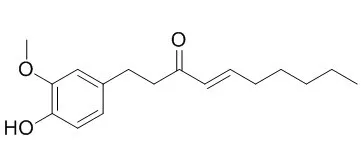| Kinase Assay: |
| Chem Biol Interact. 2015 Feb 25;228:69-78. | | 6-Shogaol enhances renal carcinoma Caki cells to TRAIL-induced apoptosis through reactive oxygen species-mediated cytochrome c release and down-regulation of c-FLIP(L) expression.[Pubmed: 25619640] | 6-Shogaol, a potent bioactive compound in ginger (Zingiber officinale Roscoe), has been reported for anti-inflammatory and anti-cancer activity.
METHODS AND RESULTS:
In this study, we investigated the effect of 6-Shogaol to enhance tumor necrosis factor-related apoptosis-inducing ligand (TRAIL)-mediated apoptosis. The combined treatment with 6-Shogaol and TRAIL markedly induces apoptosis in various cancer cells (renal carcinoma Caki cells, breast carcinoma MDA-MB-231 cells and glioma U118MG cells), but not in normal mesangial cells and normal mouse kidney cells. 6-Shogaol reduced the mitochondrial membrane potential (MMP) and released cytochrome c from mitochondria to cytosol via Bax activation. Furthermore, we found that 6-Shogaol induced down-regulation of c-FLIP(L) expression at the post-translational levels and the overexpression of c-FLIP(L) markedly inhibited 6-Shogaol plus TRAIL-induced apoptosis. Moreover, 6-Shogaol increased reactive oxygen species (ROS) production in Caki cells. Pretreatment with ROS scavengers attenuated 6-Shogaol plus TRAIL-induced apoptosis through inhibition of MMP reduction and down-regulation of c-FLIP(L) expression.
CONCLUSIONS:
Taken together, our results demonstrated that 6-Shogaol enhances TRAIL-mediated apoptosis in renal carcinoma Caki cells via ROS-mediated cytochrome c release and down-regulation of c-FLIP(L) expression. | | AAPS J. 2014 Mar;16(2):246-57. | | Antitumor activity of gemcitabine can be potentiated in pancreatic cancer through modulation of TLR4/NF-κB signaling by 6-shogaol.[Pubmed: 24424498] | Advanced pancreatic cancer still has a poor prognosis, even with the approval of several drugs, such as gemcitabine. Therefore, developing effective and safe antitumor agents is urgently needed. 6-Shogaol, a phenol extracted from ginger, has been linked to suppression of proliferation and survival of cancer with different mechanisms.
METHODS AND RESULTS:
In the present study, we investigated whether 6-Shogaol could suppress pancreatic cancer progress and potentiate pancreatic cancer to gemcitabine treatment in vitro and in vivo. We found that 6-Shogaol prevented the activation of toll like receptor 4 (TLR4)/NF-κB signaling. The modulation of NF-κB signaling by 6-Shogaol was ascertained by electrophoretic mobility shift assay and western blot analysis. The suppression of NF-κB signaling and key cell survival regulators including COX-2, cyclinD1, survivin, cIAP-1, XIAP, Bcl-2, and MMP-9 brought the anti-proliferation effects in pancreatic cancer cells and sensitized them to gemcitabine treatment. Furthermore, in a pancreatic cancer xenograft model, we found a decreased proliferation index (Ki-67) and increased apoptosis by TUNEL staining in 6-Shogaol treated tumors. It was also shown that 6-Shogaol combined with gemcitabine treatment was more effective than drug alone, consistent with the downregulation of NF-κB activity along with its target genes COX-2, cyclinD1, survivin, cIAP-1, and XIAP.
CONCLUSIONS:
Overall, our results suggest that 6-Shogaol can inhibit the growth of human pancreatic tumors and sensitize them to gemcitabine by suppressing of TLR4/NF-κB-mediated inflammatory pathways linked to tumorigenesis. |
|
| Animal Research: |
| Bmc Pharmacology, 2006, 6(1):12. | | 6-Shogaol reduced chronic inflammatory response in the knees of rats treated with complete Freund's adjuvant.[Pubmed: 17010215 ] | 6-Shogaol is one of the major compounds in the ginger rhizome that may contribute to its anti-inflammatory properties.
METHODS AND RESULTS:
Confirmation of this contribution was sought in this study in Sprague- Dawley rats (200-250 g) treated with a single injection (0.5 ml of 1 mg/ml) of a commercial preparation of complete Freund's Adjuvant (CFA) to induce monoarthritis in the right knee over a period of 28 days. During this development of arthritis, each rat received a daily oral dose of either peanut oil (0.2 ml-control) or 6-Shogaol (6.2 mg/Kg in 0.2 ml peanut oil).
Within 2 days of CFA injection, the control group produced maximum edematous swelling of the knee that was sustained up to the end of the investigation period. But, in the 6-Shogaol treated group, significantly lower magnitudes of unsustained swelling of the knees (from 5.1 +/- 0.2 mm to 1.0 +/- 0.2 mm, p < 0.002, n = 6) were produced during the investigation period. Unsustained swelling of the knees (from 3.2 +/- 0.6 mm to 0.8 +/- 1.1 mm, p < 0.00008, n = 6) was also produced after 3 days of treatment with indomethacin (2 mg/Kg/day) as a standard anti-inflammatory drug, but during the first 2 days of drug treatment swelling of the knees was significantly larger (11.6 +/- 2.0 mm, p < 0.0002, n = 6) than either the controls or the 6-Shogaol treated group of rats. This exaggerated effect in the early stage of indomethacin treatment was inhibited by montelukast, a cysteinyl leukotriene receptor antagonist. Also, 6-Shogaol and indomethacin were most effective in reducing swelling of the knees on day 28 when the controls still had maximum swelling. The effect of 6-Shogaol compared to the controls was associated with significantly lower concentration of soluble vascular cell adhesion molecule-1 (VCAM-1) in the blood and infiltration of leukocytes, including lymphocytes and monocytes/macrophages, into the synovial cavity of the knee. There was also preservation of the morphological integrity of the cartilage lining the femur compared to damage to this tissue in the peanut oil treated control group of rats.
CONCLUSIONS:
From these results, it is concluded that 6-Shogaol reduced the inflammatory response and protected the femoral cartilage from damage produced in a CFA monoarthritic model of the knee joint of rats. |
|






 Cell. 2018 Jan 11;172(1-2):249-261.e12. doi: 10.1016/j.cell.2017.12.019.IF=36.216(2019)
Cell. 2018 Jan 11;172(1-2):249-261.e12. doi: 10.1016/j.cell.2017.12.019.IF=36.216(2019) Cell Metab. 2020 Mar 3;31(3):534-548.e5. doi: 10.1016/j.cmet.2020.01.002.IF=22.415(2019)
Cell Metab. 2020 Mar 3;31(3):534-548.e5. doi: 10.1016/j.cmet.2020.01.002.IF=22.415(2019) Mol Cell. 2017 Nov 16;68(4):673-685.e6. doi: 10.1016/j.molcel.2017.10.022.IF=14.548(2019)
Mol Cell. 2017 Nov 16;68(4):673-685.e6. doi: 10.1016/j.molcel.2017.10.022.IF=14.548(2019)